Narragansett Bay, located in Rhode Island, is a beautiful and vibrant estuary that serves as a vital ecological and economic resource to the many communities that call it home. The bay spans 28 miles and is fed by three major rivers, making it a unique environment for a diverse array of plants and animals.
Although much of the focus on Narragansett Bay is on its surface, what lies beneath is just as fascinating. The bay is home to a variety of marine life, from microscopic plankton and benthic animals to shrimp, snails, clams, and killifish. The creatures that live at the bottom of the bay play an important role in maintaining the ecological balance and providing essential resources for the surrounding communities.
In this article, we will explore some of the fascinating animals that call the bottom of Narragansett Bay home, and learn about their unique characteristics, behaviors, and importance to the local ecosystem. Let’s go!
What Lives at the Bottom of the Narragansett Bay?

Beavertail Lighthouse at the entrance to Narragansett Bay on Conanicut Island. There are many organisms living in Narragansett Bay.
©Wangkun Jia/Shutterstock.com
It is important to keep in mind that the composition of the organisms living at the bottom of Narragansett Bay varies widely depending on different variables such as the location, the season, and the level of pollution, among others.
With this being said, there are several types of animals and creatures that live at the bottom of Narragansett Bay. Some of these include:
1. Shrimp

Shrimp can be found at the bottom of Narragansett Bay.
©The Pirates/Shutterstock.com
Shrimp is one of the important crustaceans that inhabit the bottom of Narragansett Bay. Along with crabs and lobsters, shrimp play a significant role in maintaining the ecological balance of the bay.
The common shrimp species found in Narragansett Bay is the northern pink shrimp. These small shrimp can grow up to three inches in length and are usually found around rocky or sandy areas of the bay. They feed on other small invertebrates and organic debris in the sediment.
Northern pink shrimp are an important food source for many of the larger animals that inhabit the bay, including fish, birds, and seals, among others. They are also exploited commercially and are widely used in the seafood industry.
However, like other species that call Narragansett Bay home, northern pink shrimp populations face threats such as habitat loss, predation, and overfishing. It is important to balance the use of resources and protect the delicate ecosystem of the bay to ensure the sustainability of the fishery and the livelihoods that rely on it.
Shrimp in Narragansett Bay plays an essential role in the ecological balance of the ecosystem, and their presence is an indication of a healthy and productive environment.
2. Snails

Many species of snails can be found on the bottom of Narragansett Bay.
©O’KHAEN/Shutterstock.com
There are a number of species of snails that can be found living at the bottom of Narragansett Bay. One such species is the mud snail, also known as Ilyanassa trivittata. Mud snails are small, typically less than an inch in length, and are commonly found in the intertidal and subtidal regions of the bay. They feed on a variety of small plants and animals, such as diatoms and detritus, and are an important part of the Bay’s food web.
Another species of snail that can be found in Narragansett Bay is the periwinkle, which is also a common snail found along the rocky intertidal regions of many coastal areas. Periwinkles are often used as bait for fishing and are also harvested for sale as seafood.
Snails are an important part of the benthic community in Narragansett Bay, providing food for both other benthic organisms and larger predators such as fish and birds. However, like other species in the bay, snail populations may face threats such as overfishing, pollution, and habitat loss, which can negatively impact the health of the bay’s ecosystem.
3. Clams

Quahog clams are hard-shelled invertebrates that can be found at the bottom of Narragansett Bay.
©Gabe Dubois/Shutterstock.com
Clams are a common benthic organism that can be found at the bottom of Narragansett Bay, particularly quahog clams. Quahogs are one of the most important commercial species in the bay, and they are very important to the economy of Rhode Island and the surrounding states.
Quahogs are often harvested using rakes or dredges, and they can also be farmed in aquaculture operations. These clams play an essential role in the bay’s ecosystem by filtering the water to remove excess nutrients, and they are also an important food source for other organisms in the area.
However, there have been concerns about the sustainability of quahog populations in the bay. Factors such as overfishing, pollution, and habitat loss can all impact the health of clam populations. Researchers and environmental agencies are working to monitor and protect these populations in order to maintain a healthy ecosystem and a sustainable fishery.
In addition to quahogs, there are many other species of clams found in Narragansett Bay, including soft-shell clams, razor clams, and surf clams. Each of these species has slightly different habitat preferences and ecological roles, but they all play an important part in maintaining the health and productivity of the bay’s ecosystem.
4. Worms

Polychaetes are a type of worm found at the bottom of Narragansett Bay.
©Anton Peichev/Shutterstock.com
Worms are a common inhabitant of the benthic, or bottom-dwelling, community in Narragansett Bay. In fact, they are one of the most diverse and abundant groups of animals found in the sediment of the bay.
There are many different species of worms that can be found in the bay, including polychaetes, which are segmented worms with many bristles, and oligochaetes, which are non-segmented worms without bristles. Worms play an important role in the bay’s ecosystem by aerating the sediment and breaking down organic matter, which contributes to nutrient cycling and the health of the bay’s food web.
Some species of worms are also important as a food source for other organisms in the bay, such as fish and birds. However, like other species in the bay, worms may face threats such as pollution, habitat loss, and overfishing, which can negatively impact their populations and the health of the ecosystem.
Worms in Narragansett Bay play an essential role in maintaining the ecological balance of the bay, and their presence is an indication of a healthy and productive environment.
5. Crabs
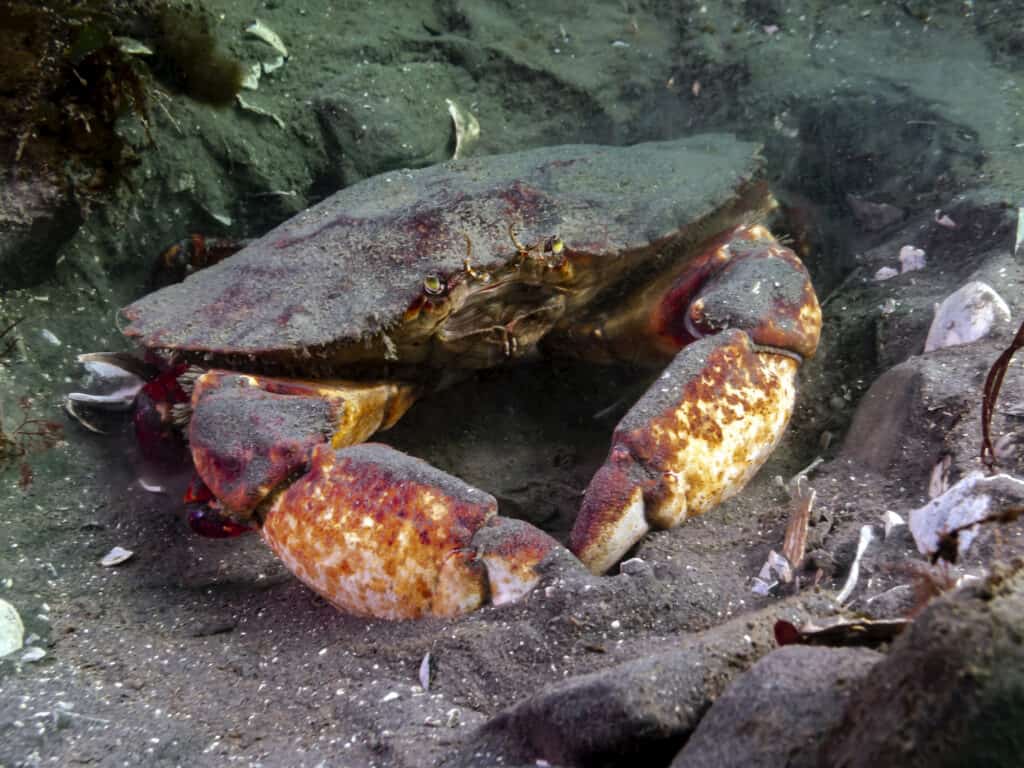
Rock crabs are a species of crab found at the bottom of Narragansett Bay.
©iStock.com/naturediver
There are various species of crabs that can be found at the bottom of Narragansett Bay. According to some of the search results, some of the most common species of crabs found in the bay include blue crabs, rock crabs, and spider crabs. These crabs are an important part of the bay’s ecosystem, serving as both predator and prey. They feed on a variety of organisms, including smaller crabs, worms, and shellfish, and are in turn eaten by larger predators such as fish and birds.
The health and abundance of crab populations in Narragansett Bay are important indicators of the overall health of the bay’s ecosystem. However, like other species in the bay, crab populations may face threats such as pollution, overfishing, and habitat loss. For example, it has been suggested that increased water temperatures associated with climate change may be affecting the distribution and abundance of blue crabs in the bay.
Efforts are underway to protect and manage these populations, through measures such as regulations on fishing and monitoring of crab populations.
6. Lobsters
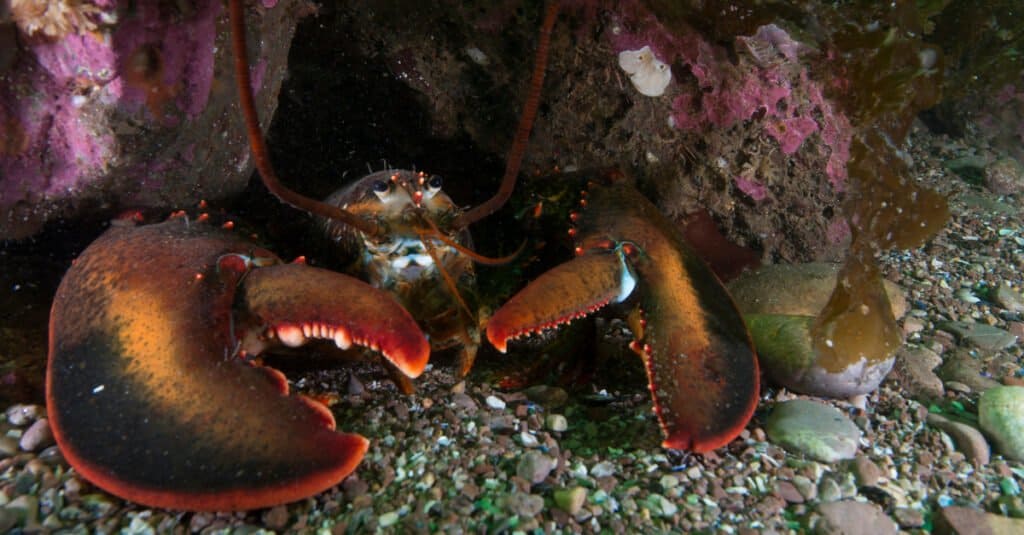
The American lobster lives at the bottom of Narragansett Bay.
©RLS Photo/Shutterstock.com
Lobsters are a common benthic organism that can be found at the bottom of Narragansett Bay. The American lobster, or Homarus americanus, is one of the most famous species of lobster found in the bay and is an important commercial species for the Rhode Island seafood industry. Lobsters are often caught using traps, and they are also farmed in aquaculture operations.
However, like other species in the bay, lobsters may face threats such as overfishing, habitat loss, and pollution, which can negatively impact their populations and the health of the ecosystem. For example, lobsters in the bay have been affected by shell disease, which can cause significant mortality rates.
Climate change is also a concern for lobster populations in the bay, as warming waters and changes in ocean currents and chemistry may affect lobster distribution and abundance. In addition, lobsters may also be impacted by changes in the distribution and abundance of their prey and predators.
7. Mussels
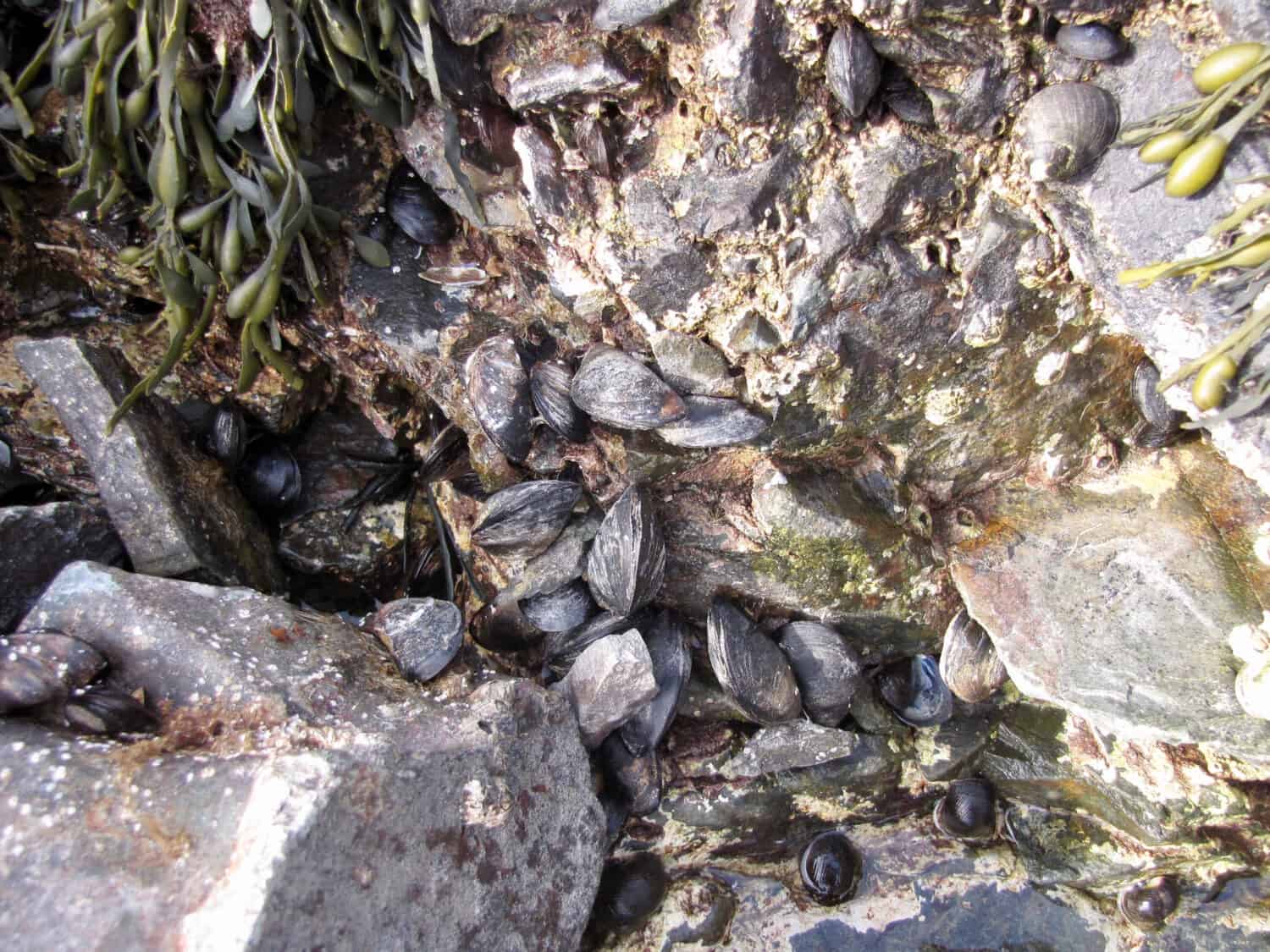
Mussels are a common sight at the bottom of Narragansett Bay.
©JonPeckham/Shutterstock.com
Mussels are another benthic organism commonly found at the bottom of Narragansett Bay. Different species of mussels, including the Whitewater mussel, can be found in the bay.
Mussels play a vital role in the bay’s ecosystem by filtering water and removing contaminants, such as excess nutrients and pollutants. In addition, they serve as a food source for many other organisms, including humans.
However, mussel populations in the bay have faced challenges due to pollution and habitat loss. For example, in the past, there have been instances of mussel die-offs in the bay due in part to low oxygen levels caused by nutrient pollution.
Efforts are being made to protect and restore mussel populations in the bay. For example, the Narragansett Bay Estuary Program and other organizations are working to reduce nutrient and pollution inputs to the bay, which can help improve the health of mussel populations. Additionally, there are also aquaculture operations that farm mussels in the bay and nearby areas, which can help support a sustainable seafood industry in the region.
8. Barnacles
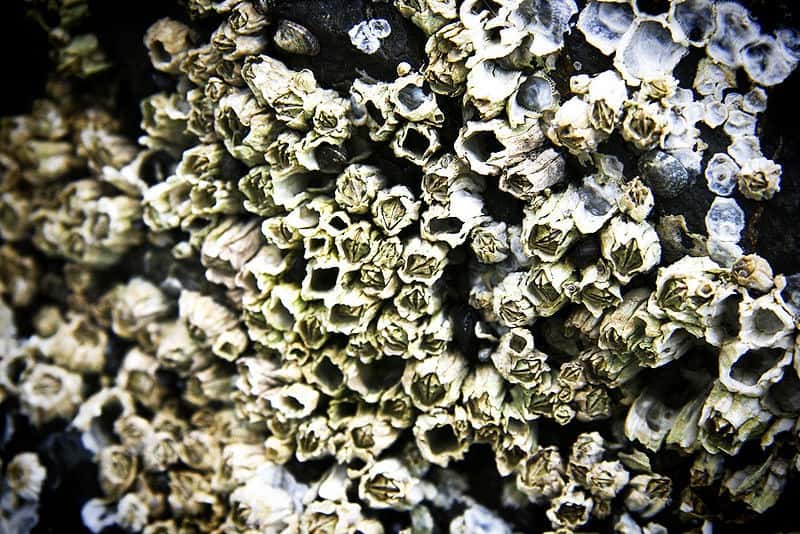
Barnacles can be found at the bottom of Narragansett Bay.
Barnacles are filter feeders, and they attach themselves to hard substrates such as rocks or pilings using a hard, calcified shell. They can be an important food source for many organisms in the bay, including sea stars, fish, and birds. There are several species of barnacles found in the bay, including the acorn barnacle and the small grey barnacle, Chthamalus fragilis.
Barnacle populations in the bay may also face challenges due to pollution and habitat loss. For example, growth on boat hulls can introduce non-native species of barnacles and other organisms that can compete with or displace native populations.
Efforts are underway to study and protect barnacle populations in the bay. For example, there is a study on genetic variation in the acorn barnacle from Narragansett Bay, which can help researchers better understand the ecology and population dynamics of this important species.
9. Sea Urchins
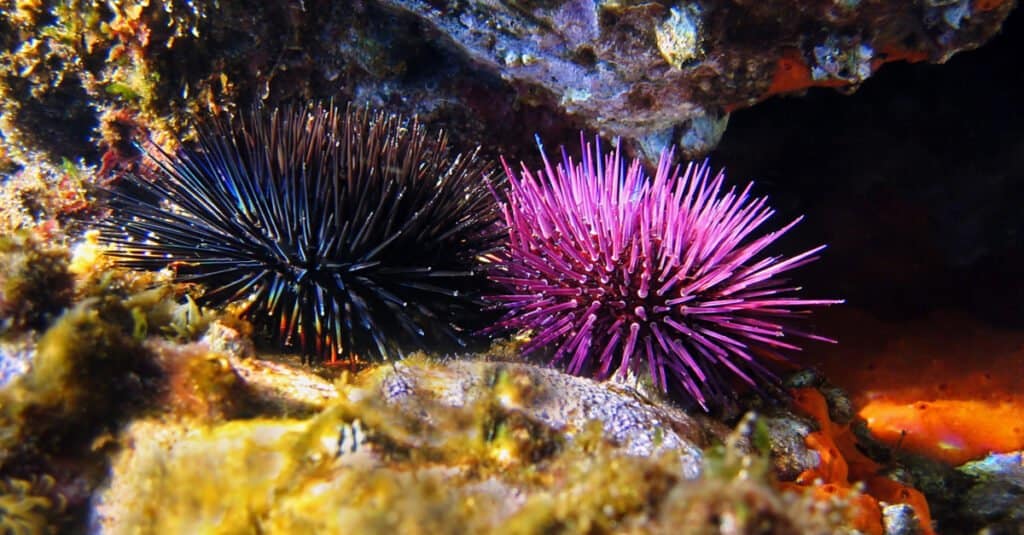
Sea urchins use their spiked shells to protect themselves from predators. These creatures can be found in Narragansett Bay.
©Damsea/Shutterstock.com
Sea urchins can be found at the bottom of Narragansett Bay. In fact, there is a study where researchers are feeding microplastic fibers to sea urchins in the bay to understand the impacts of microplastic pollution on marine organisms.
Sea urchins are echinoderms and are related to sea stars and sand dollars. They have a hard, spiny shell and can often be seen clinging to rocks or other hard substrate at the bottom of the bay. Sea urchins are omnivores and can feed on a variety of organisms, including algae, plankton, and detritus.
Sea urchin populations in the bay can be impacted by factors such as pollution, habitat loss, and predation. For example, overfishing of predator species such as lobsters and sea stars can lead to an increase in sea urchin populations, which can in turn have negative impacts on other organisms such as kelp. However, sea urchins can also be important in maintaining healthy ecosystems, as they can help control algae growth and promote the diversity of other organisms.
Overall, sea urchins are an important component of the marine ecosystem at the bottom of Narragansett Bay, and efforts are underway to better understand and protect their populations.
10. Microscopic Plankton

Several types of microscopic plankton are in Narragansett Bay, including phytoplankton.
©Choksawatdikorn/Shutterstock.com
Plankton are typically found throughout the water column, including the bottom. Plankton is a diverse group of organisms that play a crucial role in marine ecosystems, serving as the base of the food chain and helping to regulate the Earth’s climate through their role in biogeochemical cycles.
Several plankton are in Narragansett Bay, including phytoplankton and diatoms. Phytoplankton are tiny, single-celled plants that are capable of photosynthesis, and are an important source of food for many marine organisms. Diatoms are a type of phytoplankton that are characterized by their intricate, silica cell walls and are also an important food source in the bay.
Plankton populations can vary depending on factors such as season, nutrient availability, and other environmental conditions, and more research may be needed to understand the specific plankton populations present at the bottom of the bay.
In Conclusion
Narragansett Bay is a complex and diverse ecosystem with numerous species of plants, animals, and microorganisms living throughout its various habitats, including the bottom of the bay. While research on specific species and populations is ongoing, it is clear that the bay is home to a wide range of organisms, from sea urchins and crabs to microscopic plankton.
These species play important roles in maintaining the health of the bay’s ecosystem, and efforts to conserve and protect these habitats are essential in preserving the biodiversity of this unique and valuable ecosystem for future generations to enjoy. As we continue to learn more about the species that inhabit the bottom of Narragansett Bay, we can better appreciate the vital role they play in this complex and fascinating ecosystem.
The photo featured at the top of this post is © iStock.com/Paul Hamilton
Thank you for reading! Have some feedback for us? Contact the AZ Animals editorial team.







